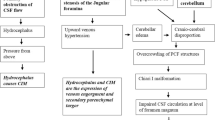Abstract
Introduction
Acquired Chiari type-I malformation in hydrocephalic patients who have undergone surgical treatment was initially thought to depend on a craniocephalic disproportion induced by the cerebrospinal (CSF) shunt. However, most of the reports in the literature deal with children with lumbo-peritoneal shunts and emphasize the pathogenic role of the cranio–spinal pressure differential across the foramen magnum brought about by this type of shunt.
Method
In the present report, the authors describe two further cases of symptomatic acquired Chiari type-I malformation observed in two adolescents operated on for correction of pseudotumor cerebri in one (lumbo-peritoneal shunt) and of a suprasellar arachnoid cyst (cysto-ventriculo-peritoneal shunt) in the other.
Results
In both subjects, both the clinical manifestations and the cerebellar tonsillar herniation regressed after supratentorial cranial expansion, without the need for any manipulation of the shunt devices implanted earlier.
Discussion
These results, together with the observation of the concomitant upward and downward herniation of the cerebellum in both patients, indicate that secondary craniocephalic disproportion plays a relevant role in the genesis of acquired Chiari type-I malformation in children bearing extrathecal CSF shunts.







Similar content being viewed by others
References
Hoffman HJ, Tucker SW (1976) Cephalocranial disproportion. A complication of the treatment of hydrocephalus in children. Childs Brain 2:167–176
Welch K, Shillito J, Strand R, Fischer EG, Winston KR (1981) Chiari I “malformation”—an acquired disorder? J Neurosurg 55:604–609
Payner TD, Prenger E, Berger TS, Crone KR (1994) Acquired Chiari malformations: incidence, diagnosis, and management. Neurosurgery 34:429–434
Cinalli G, Renier D, Sebag G, Sainte-Rose C, Arnaud E, Pierre-Kahn A (1995) Chronic tonsillar herniation in Crouzon’s and Apert’s syndromes: the role of premature synostosis of the lambdoid suture. J Neurosurg 83:575–582
Chumas PD, Armstrong DC, Drake JM, Kulkarni AV, Hoffman HJ, Humphreys RP, Rutka JI, Hendrick EB (1993) Tonsillar herniation: the rule rather than the exception after lumboperitoneal shunting in the pediatric population. J Neurosurg 78:568–573
Chumas PD, Kulkarni AV, Drake JM, Hoffman HJ, Humphreys RP, Rutka JT (1993) Lumboperitoneal shunting: a retrospective study in the pediatric population. Neurosurgery 32:376–383
Amin-Hanjani S, Sathi S, Scott RM (1995) De novo Chiari I malformations in infants demonstrated by sequential magnetic resonance imaging scans: report of two cases. Pediatr Neurosurg 22:299–302
Atkinson LD, Kokmen E, Miller YM (1998) Evidence of posterior fossa hypoplasia in the familial variant of adult Chiari I malformation (case report). Neurosurgery 42:401–404
Cameron AH (1957) The Arnold-Chiari and other neuroanatomical malformations associated with spina bifida. J Pathol 73:195–211
van Hoytema GJ, van den Berg R (1996) Embryological studies of the posterior fossa in connection with Arnold-Chiari malformation. Dev Med Child Neurol Suppl 11:61–76
Emery JL, Mackenzie N (1973) Medullo-cervical dislocation deformity (Chiari II deformity) related to neurospinal dysraphism (meningomyelocele). Brain 96:155–162
Sathi S, Stieg PE (1993) “Acquired” Chiari I malformation after multiple lumbar punctures (case report). Neurosurgery 32:306–309
Snow RB, Kuhel W, Martin SB (1991) Prolonged lumbar spinal drainage after the resection of tumors of the skull base: a cautionary note. Neurosurgery 28:880–883
Atkinson JL, Weinshenker BG, Miller GM, Piepgras DG, Mokri B (1998) Acquired Chiari I malformation secondary to spontaneous spinal cerebrospinal fluid leakage and chronic intracranial hypotension syndrome in seven cases. J Neurosurg 88:237–242
Sullivan LP, Stears JC, Ringel SP (1998) Resolution of syringomyelia and Chiari I malformation by ventriculo-atrial shunting in a patient with pseudotumor cerebri and a lumboperitoneal shunt. Neurosurgery 22:744–742
Sullivan HC (1991) Fatal tonsillar herniation in pseudotumor cerebri. Neurology 41:1142–1144
Chumas PD, Drake JM, Del Bigio MR (1992) Death from chronic tonsillar herniation in a patient with lumboperitoneal shunt and Crouzon’s disease. Br J Neurosurg 6:595–599
Rekate HL, Wallace D (2003) Lumboperitoneal shunts in children. Pediatr Neurosurg 38:41–46
Huang PP, Constantini S (1994) “Acquired” Chiari I malformation. J Neurosurg 80:1099–1102
Holly LT, Batzdorf U (2001) Management of cerebellar ptosis following craniovertebral decompression for Chiari I malformation. J Neurosurg 94:21–26
Grieve J, Thompson D (2001) Resolution of tonsillar herniation following endoscopic third ventriculostomy. Pediatr Neurosurg 35:164–165
Girard N, Lasjaunias P, Taylor W (1994) Reversible tonsillar prolapse in vein of Galen aneurysmal malformations: report of eight cases and pathophysiological hypothesis. Childs Nerv Syst 10:141–147
Onesti ST, Ashkenazi E, Miller AM, Michelsen WJ (1997) Resolution of acquired tonsillar herniation after resection of supratentorial meningioma (case illustration). J Neurosurg 86:572
Sheehan JM, Jasr J (2000) Resolution of tonsillar herniation and syringomyelia after supratentorial tumor resection (case report and review of the literature). Neurosurgery 47:233–235
Author information
Authors and Affiliations
Corresponding author
Rights and permissions
About this article
Cite this article
Di Rocco, C., Velardi, F. Acquired Chiari type I malformation managed by supratentorial cranial enlargement. Childs Nerv Syst 19, 800–807 (2003). https://doi.org/10.1007/s00381-003-0837-7
Received:
Published:
Issue Date:
DOI: https://doi.org/10.1007/s00381-003-0837-7




